For weeks, fans have been circling this fixture on their calendars as a potential title decider. Manchester City’s recent defeat to Tottenham and draw at Crystal Palace, coupled with Liverpool’s 10 straight league wins on the spin meant that only one point separated the teams ahead of this game.
This would be the third time in four seasons where the two teams go neck and neck for the title, amassing record-breaking numbers along the way. Since the start of the 2018/19 Premier League season, City have won 338 points in the league, while Liverpool have accumulated 337. Liverpool legend Jamie Carragher claimed that this is the “Premier League’s greatest rivalry”. In terms of quality, he may not be wrong. Both teams have set the bar so high like nothing we have witnessed before. The level of consistency in performances and shear ability to win any game of football is nothing short of spectacular.
The showdown itself did not disappoint as we witnessed a high flying, breathless, end-to-end contest between the best two teams and managers in the league and arguably in Europe. The quality and tactical battles on show were truly a great advert to the Premier League.
City put the visitors under intense pressure in the first half and could have gone into the break with a bigger lead had it not been for some wasteful finishing. However, Jürgen Klopp made some adjustments in the second half as Liverpool scored a quick equalizer meaning the points were ultimately shared in the end.
This tactical analysis will break down some of the key tactics we saw in Sunday’s match.
Line-ups
Pep Guardiola introduced Gabriel Jesus on the right wing and moved Bernardo Silva to midfield alongside Rodri in a 4-2-3-1 formation that we have rarely seen from City this season.
Manchester City XI (4-2-3-1): Ederson; Kyle Walker, John Stones, Aymeric Laporte, João Cancelo; Rodrigo, Bernardo Silva; Gabriel Jesus, Kevin De Bruyne, Phil Foden; Raheem Sterling.
Jurgen Klopp approached the game in a familiar lineup that has seen the Reds win their last 10 league outings.
Liverpool XI (4-3-3): Alisson; Trent Alexander-Arnold, Joël Matip, Virgil Van Dijk, Andrew Robertson; Fabinho, Jordan Henderson, Thiago Alcântara; Mohamed Salah, Sadio Mané, Diogo Jota.
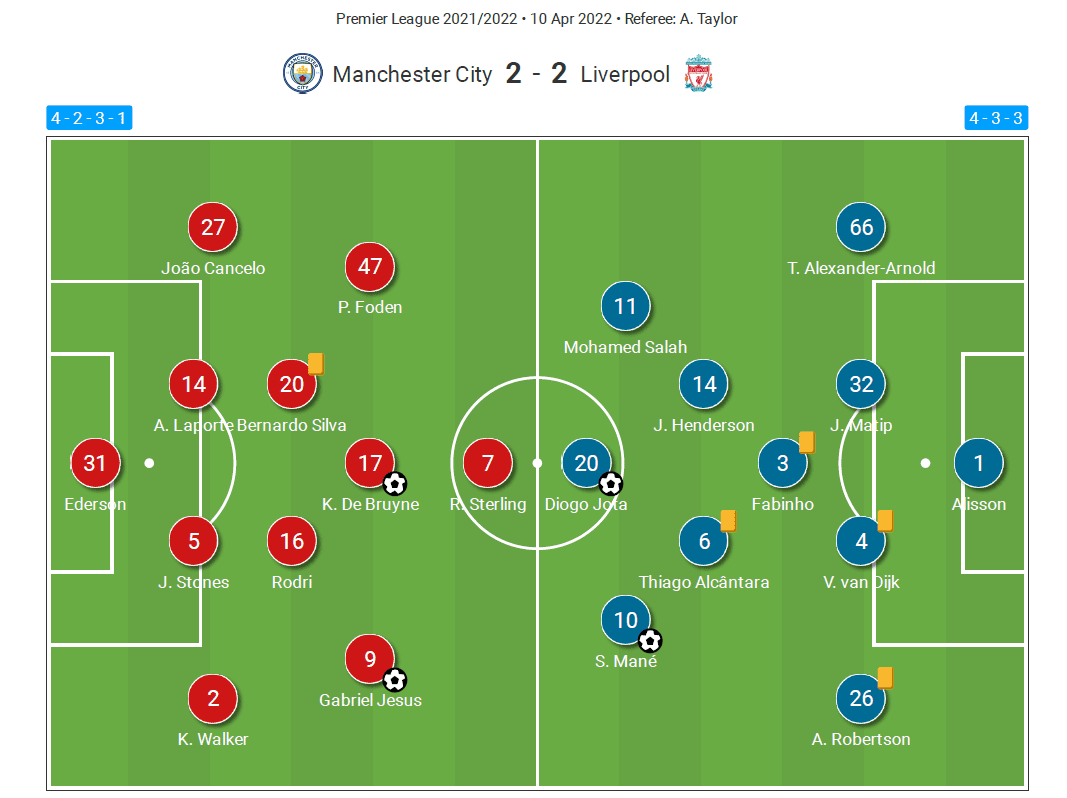
De Bruyne in the spaces
Kevin De Bruyne produced a man of the match display in a big game yet again, scoring the opener and being at his mesmerizing best throughout. At every opportunity, City looked to find De Bruyne in the spaces. He would receive the ball and turn quickly looking to play direct and vertical. From the first whistle, he was playing aggressively and making progressive drives which subsequently led to the first goal. He eludes Fabinho by a quick change of pace and gets a bit of good fortune with the deflection off Matip. KDB was constantly looking for through balls to activate the attackers.
City set up in a 4-2-3-1 formation with the ball. Bernardo Silva partnered Rodri in the double pivot, a role the Portuguese is not generally known for. Foden, Sterling and Jesus played as a narrow front three to pin the Liverpool back four and generate the spaces for De Bruyne between the lines. Foden and Jesus tucked inside to drag Alexander-Arnold and Robertson, freeing up the flanks for Cancelo and Walker to push forward.
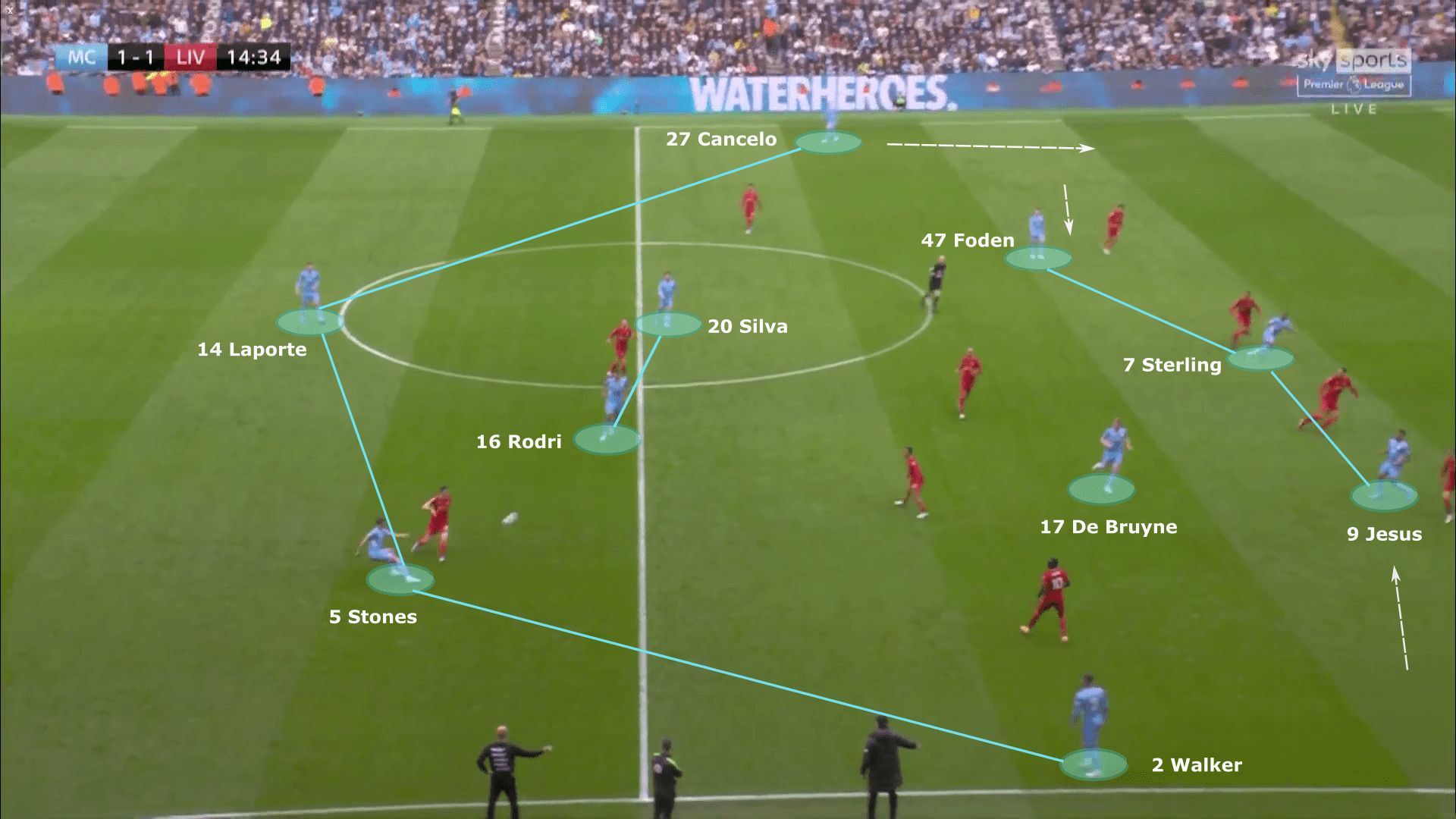
One of the main reasons Pep deployed a double pivot and wide fullbacks is to break Liverpool’s press. It also attracts the Liverpool 8s in Henderson and Thiago to cover the half-spaces using cover shadows and close down City’s midfield two. This creates the opportunity for De Bruyne to roam freely between the lines as we can see below. De Bruyne also rotated with Foden or Jesus to move out wide on several occasions.
Liverpool pressed Manchester City high to prevent them from playing their football and obtain the element of control they usually seek every time they set foot on the pitch. Klopp wanted it to become a more end to end game because it meant that his team would get more chances. But Liverpool struggled in the early stages to deal with City’s long balls from the back.
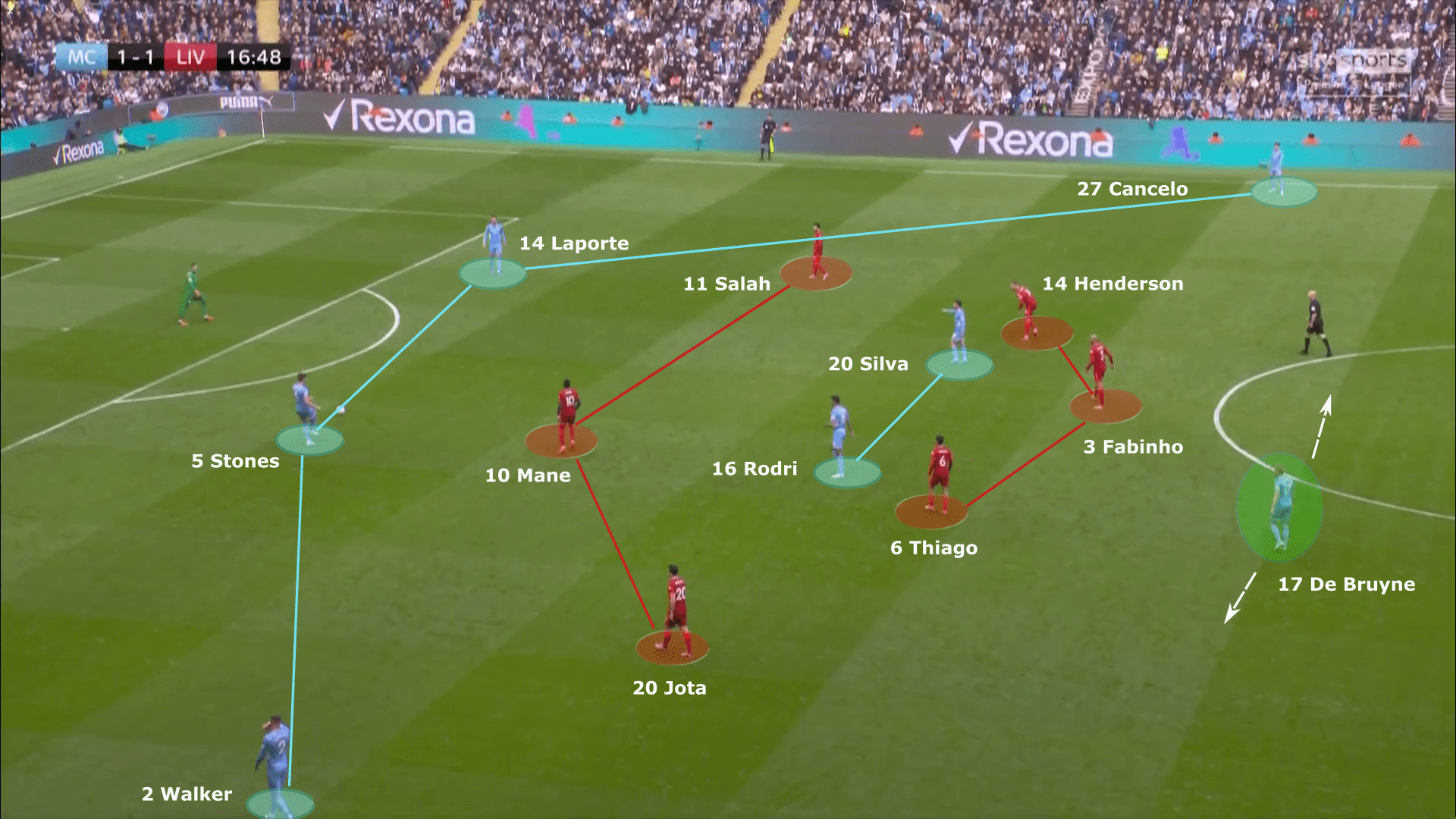
In the 63rd minute, City can be seen operating in a slightly different shape. Cancelo moves inside to create control over transitions. Walker goes high and wide to drag Mané with him and the double pivot stays deep close to Liverpool’s front players. This creates the room for De Bruyne to receive the ball freely in the danger zone. Jesus and Sterling’s forward movements meant that neither Van Dijk nor Matip could jump out to cover the City playmaker. Again, the City front three are narrow, De Bruyne collects the ball and outs Sterling through to score with a beautifully weighted pass, but the goal is chalked off for offside.
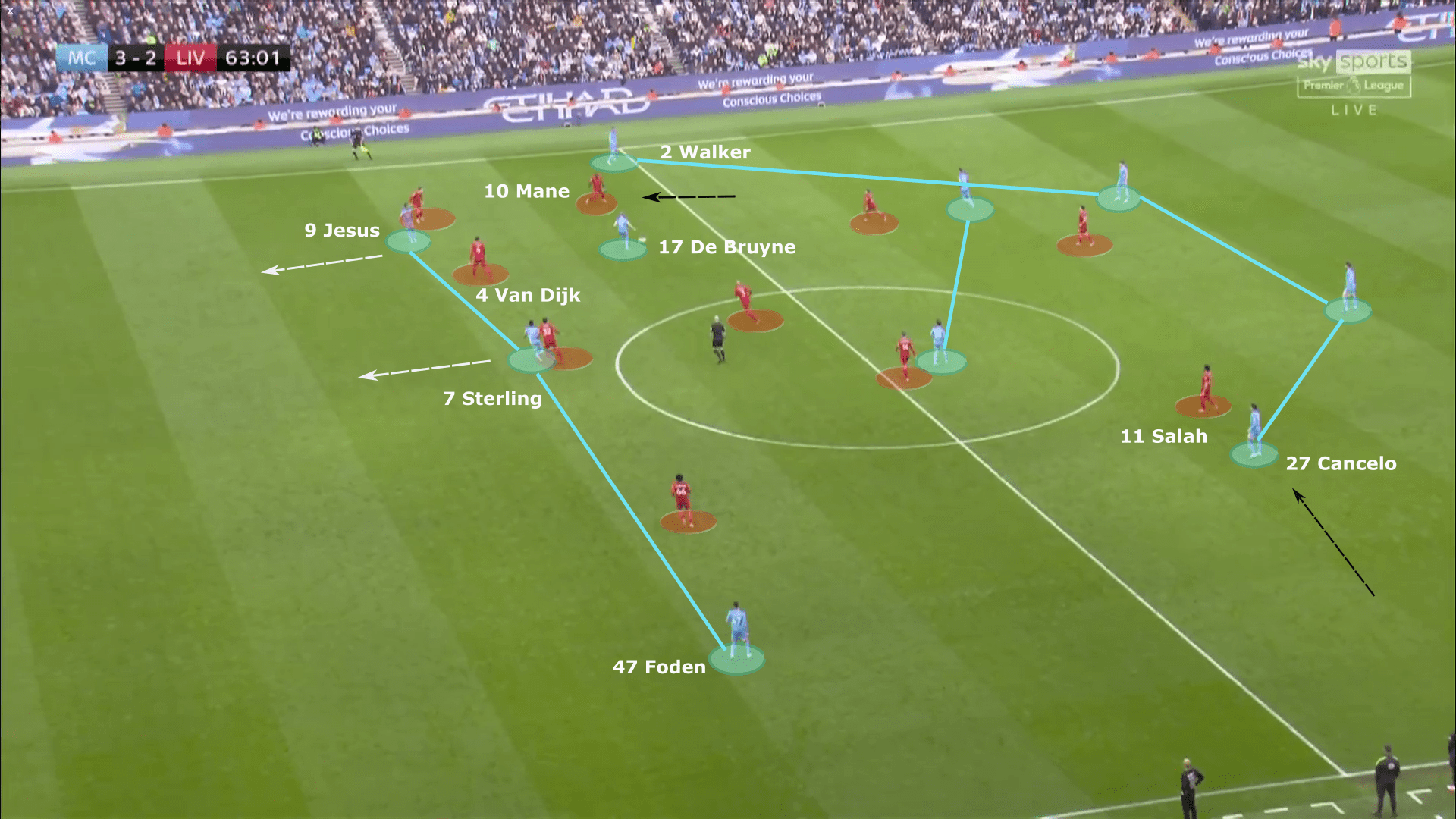
In the final minutes of the game, De Bruyne carried the ball forward with menace and found substitute Riyad Mahrez with an exquisite left-foot through ball. Mahrez shrugged off Matip and cut to his favored left side but went for a cheeky chip, only to see it sail over Alisson’s goal. The ball hitting the back of the net there could all but have been the moment that decided the title race.
Out of possession, City generally defended in a 4-4-2 with De Bruyne pushing forward alongside Sterling while Jesus, Rodri, Silva and Foden formed the midfield four. Silva and Rodri would mark Henderson and Thiago while KDB or Sterling covered Fabinho. Foden and Jesus tried to stop Liverpool’s fullbacks from receiving the ball in the half-spaces and sending long balls to the front three since they are the team’s main creative outlets.
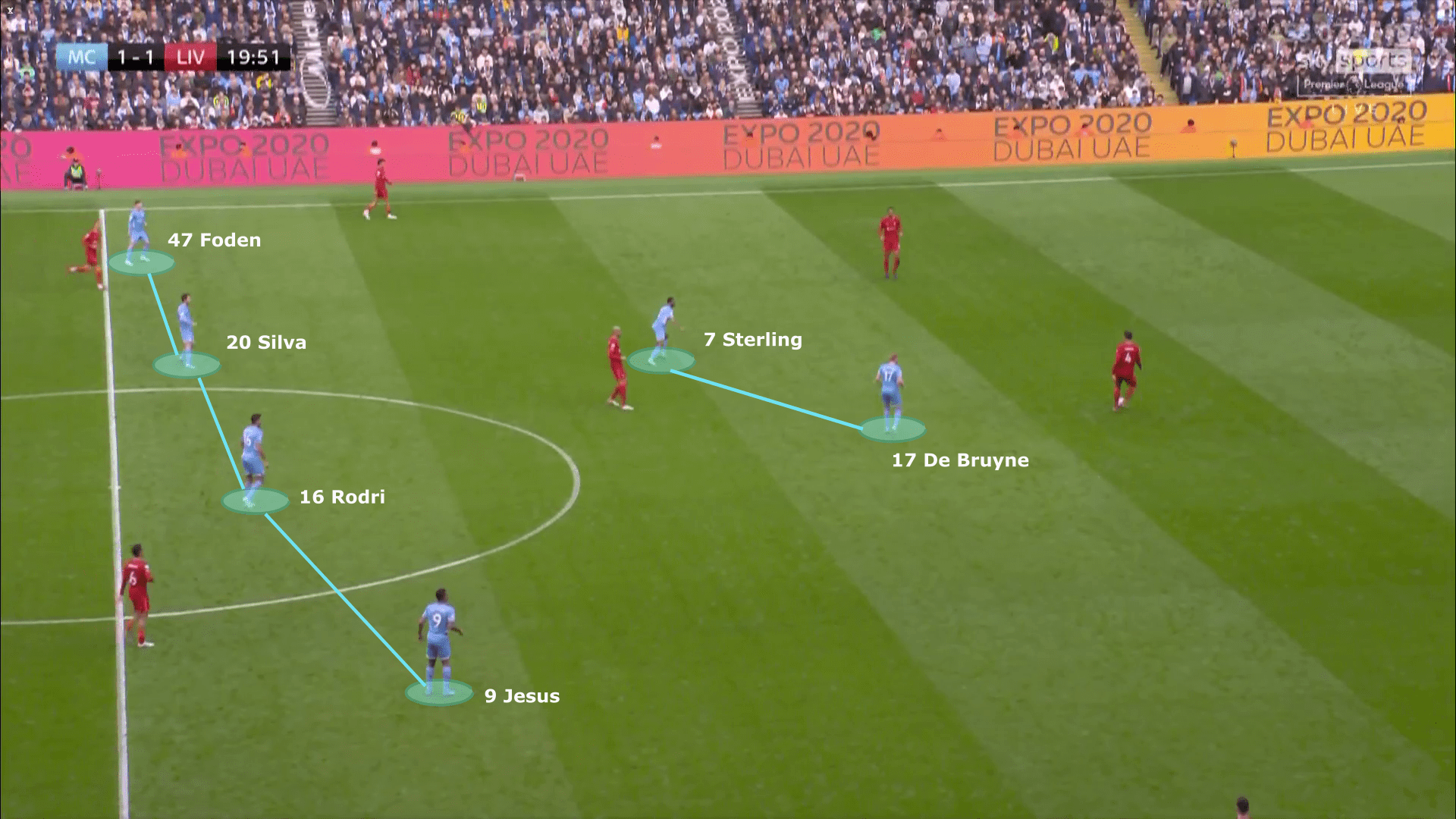
High lines and impact of fullbacks
Manchester City are used to their opponents dropping back in a compact low block, allowing them to control possession and tempo of the game, building up attacks from the back with short passes and breaking down stern defences.
Klopp being Klopp, known for rock n’ roll football and fast transitions, meant Liverpool played with an aggressive press and high line to disrupt City’s flow. “Without pressure on the ball, you cannot have a high line,” said Klopp after the game. In the first half, although it led City to play in a more direct style, it did not seem to work as Liverpool struggled to deal with the balls in behind.
In the image below, we can see how high Liverpool are and how close the distance is between back and front, Van Dijk and Jota. The 10 Liverpool players are all positioned just before and beyond the halfway line.
Foden pushes inside, creating the space out wide on the overlap for Cancelo. The two caused a lot of damage to Alexander-Arnold on the left, taking advantage of Liverpool’s weakest link at the back. City used Bernardo on the ball to distribute to the outside channels and beat Liverpool’s offside traps. Lack of tracking back from Salah and Mané made it easier for City to create 2v1 situations.
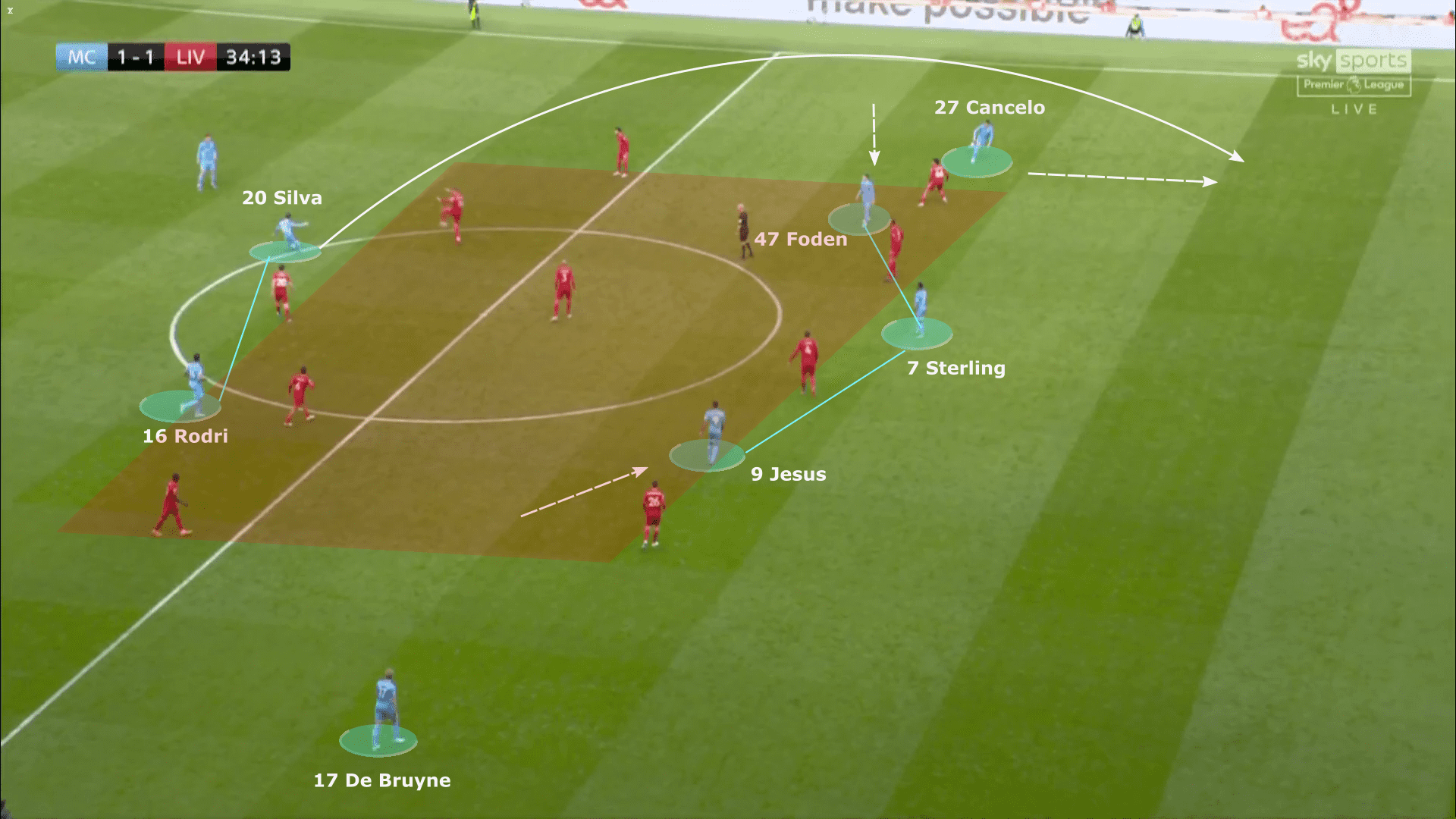
Pep opted for Foden, Sterling and Jesus as the offensive trident and it paid off. The three of them are workaholics in and out of possession while always looking to attack the gaps between the opposition defenders.
Here, Jesus tucks inside this time and drags Robertson into unwanted territory. Walker bursts forward with Mané late to run back. Again, it is Silva who pings a delightful ball forward which leads to a dangerous chance. Bernardo played at the centre of the steering wheel. Him receiving the ball would trigger the movement and rotations in the wide areas.
During the match, Man City played a total of 113 high passes, their second-highest total of the campaign.
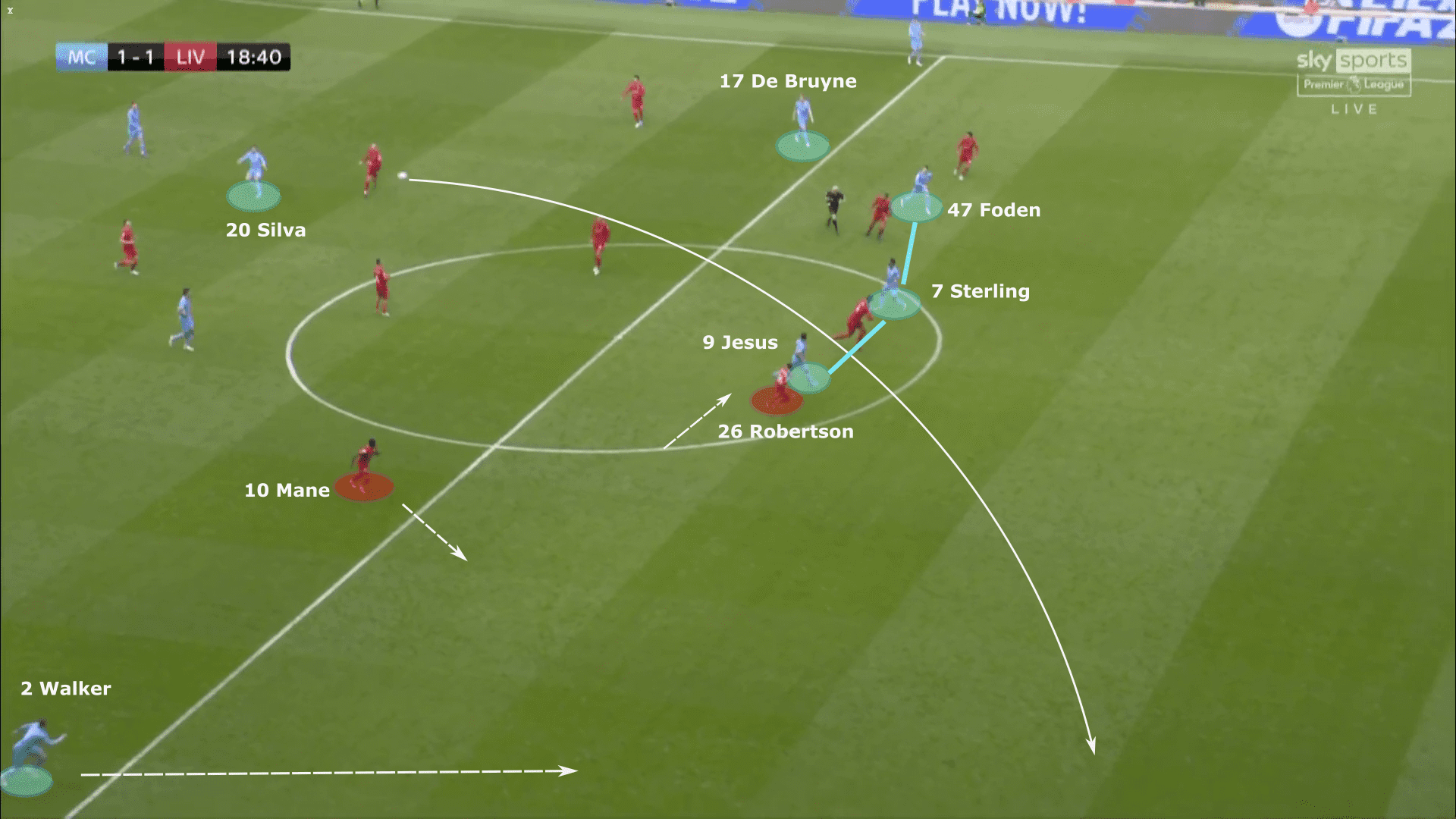
Here, De Bruyne drifts to the left and Sterling makes a movement to dislocate the CBs, thus creating the space for Jesus in behind Robertson. City’s second goal came from a similar situation where Cancelo found Jesus as Alexander-Arnold was caught in two minds whether to jump out or trackback.
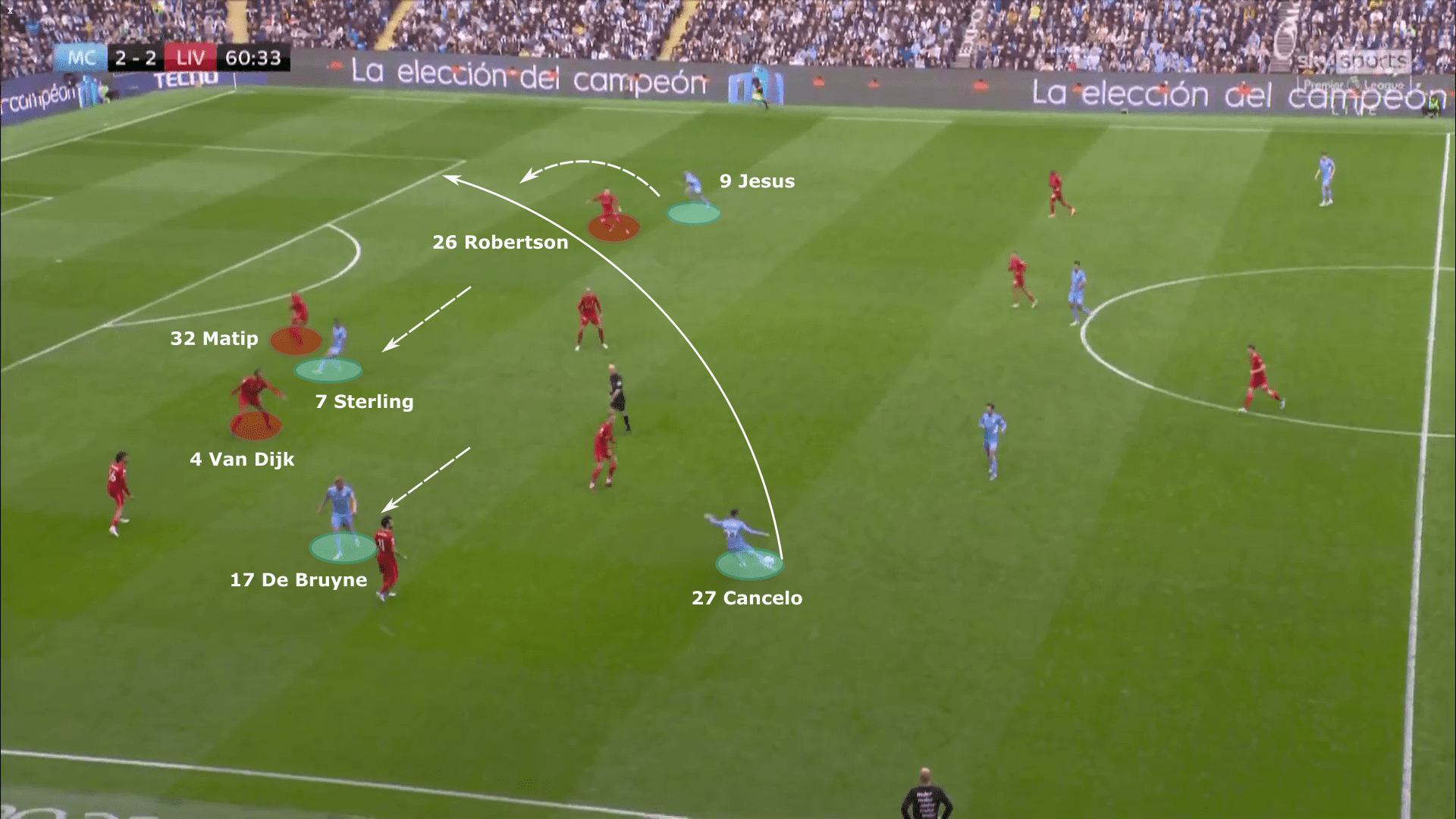
Liverpool also pushed their fullbacks up the pitch and depended on long balls over the top, as City played in a high line as they normally do. Here, Jota drops towards the ball while Salah and Mané make inside runs into the central areas. The Reds often tried to play the ball into their fullbacks and look for the runs of Salah and Mané towards goal. In addition, switches of play from left to right were effective from Robertson to Alexander-Arnold, one of them leading to the first goal by Jota against the run of play.
This type of football requires goalkeepers who are proactive to be alert and defend the spaces left behind by the back four. Several times we saw Alisson and Ederson having to sweep out and act as the last defender, something both keepers are generally known for.
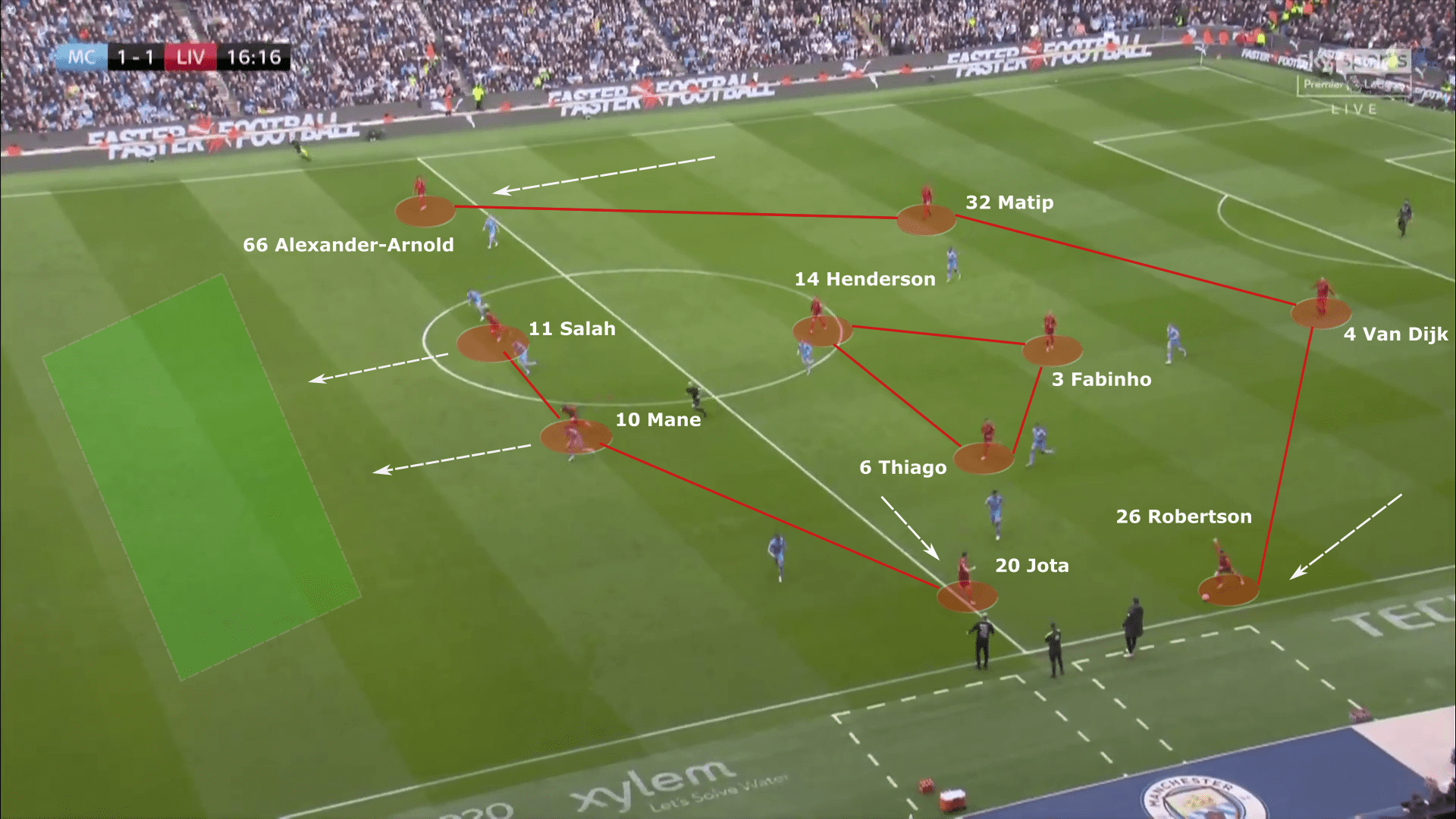
Liverpool’s second half adjustments
After being second-best in the first half, Liverpool came out of the blocks firing and scoring the equalizer less than one minute after the restart. A notable change was the position of Henderson. He played higher up the field, occupying the false fullback space and creating overloads on the right side of the pitch. Salah and Alexander-Arnold were more threatening after the break due to Henderson’s support, which also helped the team play more football on the ground. This led to the 2nd goal as Salah receives the ball from Trent to play Mané through with a pin-point pass as Walker was caught napping.
Salah has been suffering from a bit of a dip in form over the past couple of months. His last goal from open play dates back to February 19 against Norwich. The three goals that have followed since have all come from the penalty spot. This might be due to the accumulation of games especially in the AFCON, where Salah played four 120-minute games in a row. Nevertheless, he remains the league’s top scorer and showed again that he can pop up and produce a moment of quality at any time in a game to make the difference.
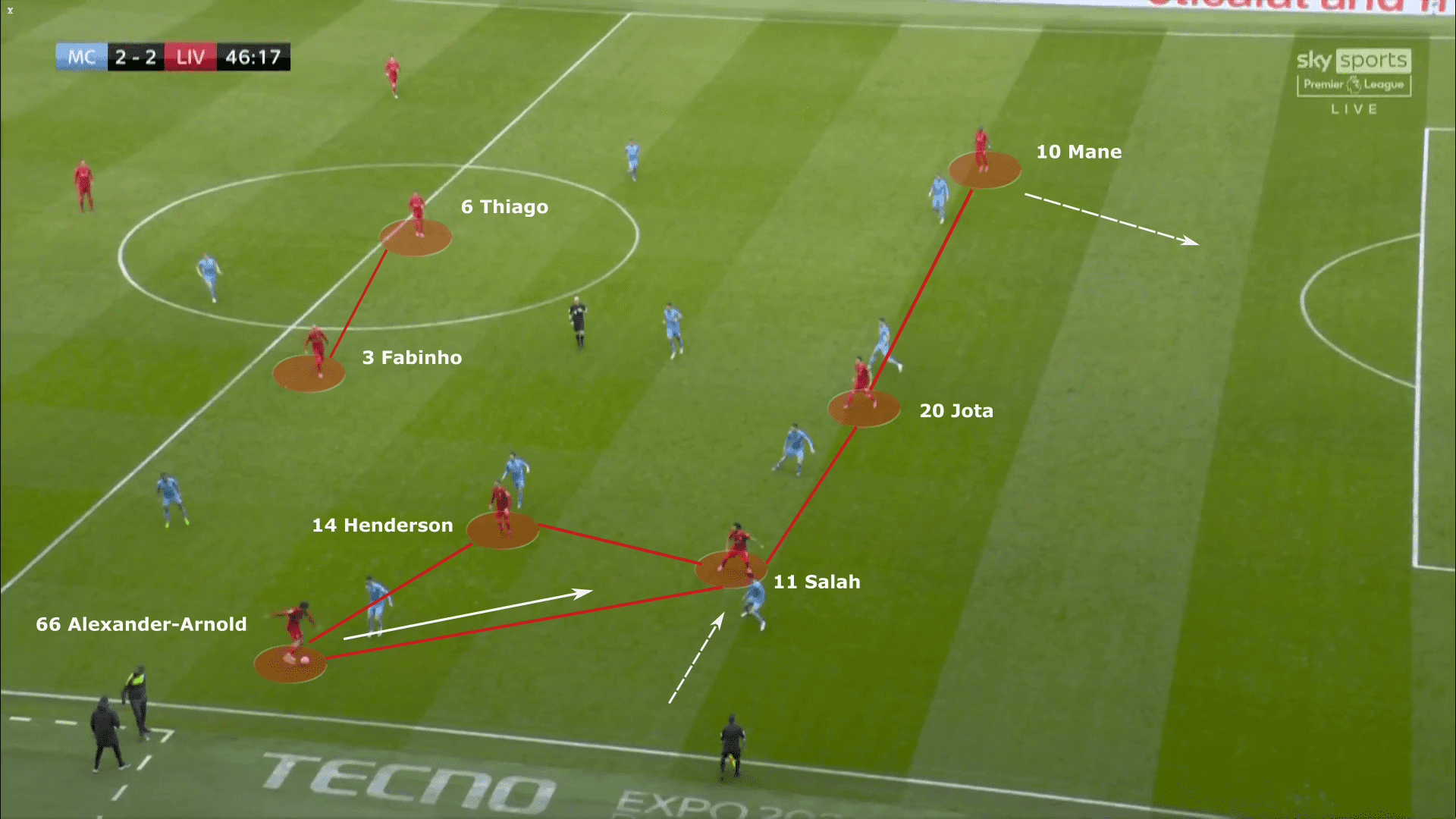
In the 48th minute, City are absorbing the Liverpool storm and have a goal kick. Bernardo goes all the way back to his goal to start the build-up. The CBs stretch out dragging Mané and Salah. Jota looks to close down Silva while Henderson covers Rodri. City’s aim was to play the outlet ball to De Bruyne but a major adjustment made by Klopp was for Fabinho, who suffered throughout the game, to stick to the Belgian and cut the passing lanes into his feet.
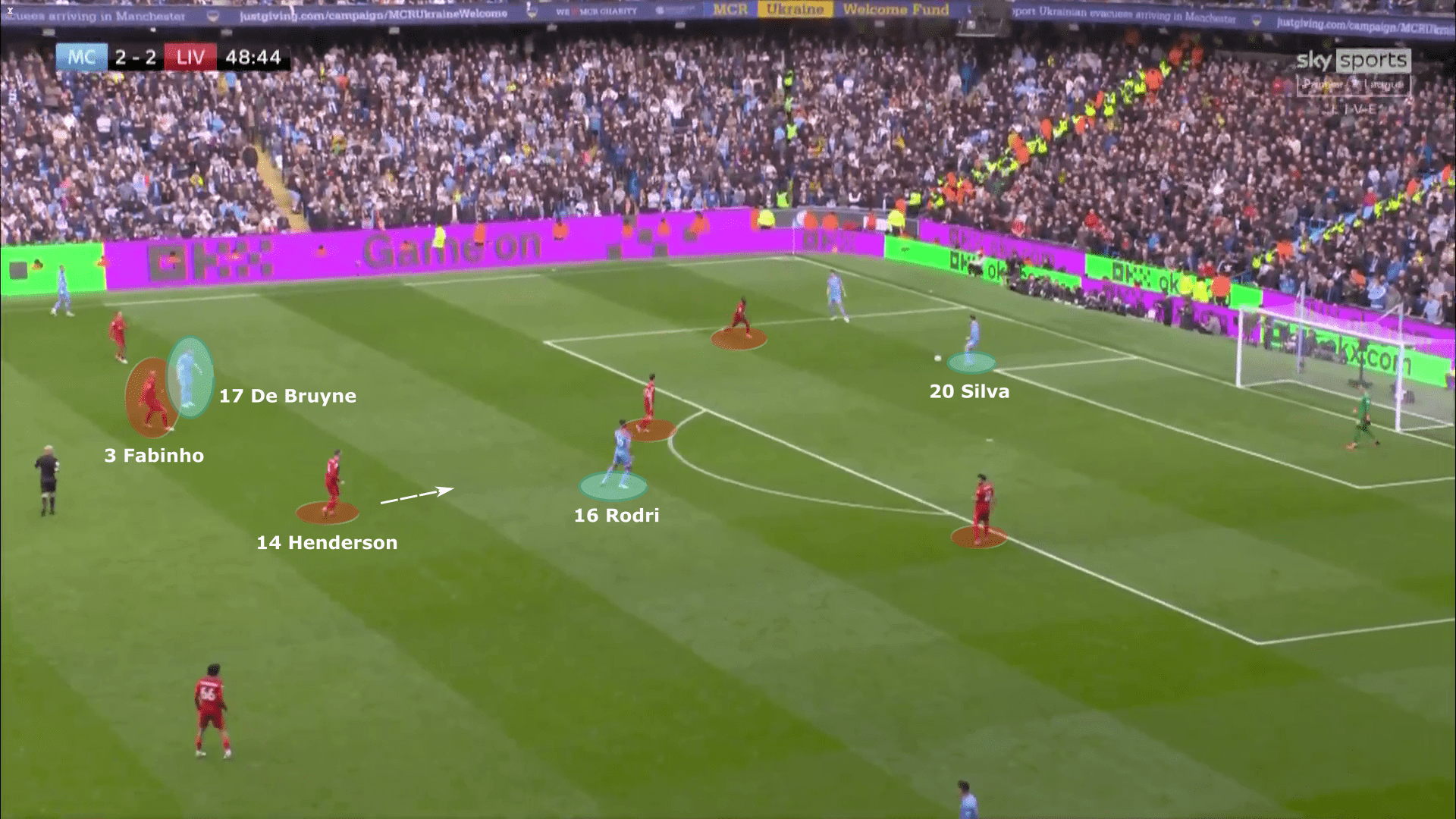
As the game progressed, Matip started moving higher up with the ball and attract a Man City attacker. Thiago would drop back as a deep-lying playmaker allowing Robertson to position himself in an advanced position. This forces Jesus to fall back and track Robertson, effectively making it a back five for City at times.
Alexander-Arnold was operating more between the lines to overload the wide half-space. The target was to free up Salah on the right wing and isolate him 1v1 with Cancelo. Henderson and Trent’s positions would lead to more penetration from Liverpool and direct passes into the final third.
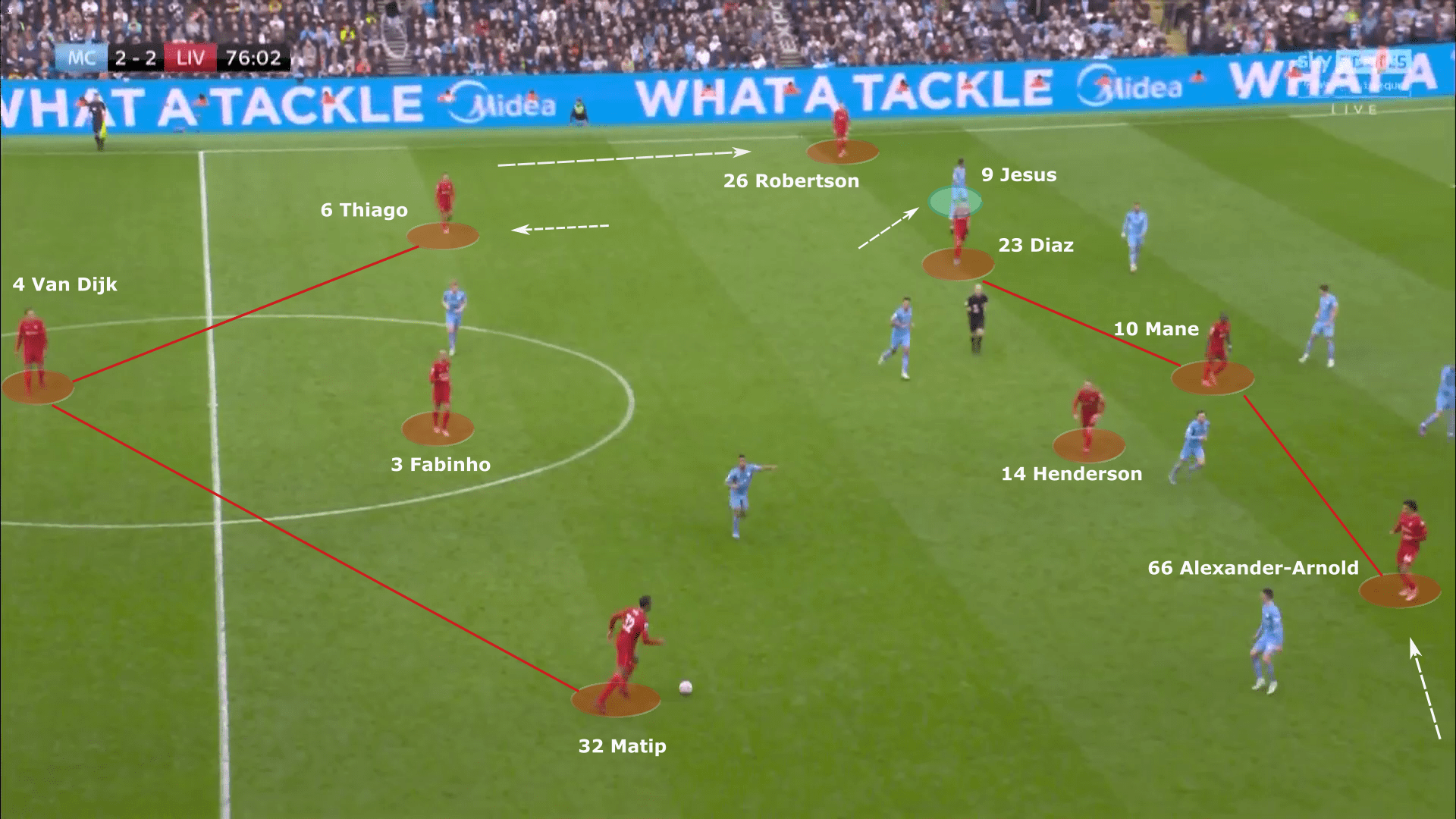
Conclusion
Neither team could find the breakthrough in the end and they had to settle for a point. Both managers will feel like this was an opportunity missed but Liverpool will be happier with the draw on the balance of play, as a loss would have effectively ended their title hopes.
The game lived up to the expectations and provided one of the enthralling tactical battles of the season. As for the race for top spot, the day finished as it started, with City leading by the one point. Liverpool now head into the last seven league games needing to presumably win them all and hope that Pep’s side slip up along the way.
Both teams will approach the games as seven cup finals. Liverpool arguably have the tougher schedule for the run-in.
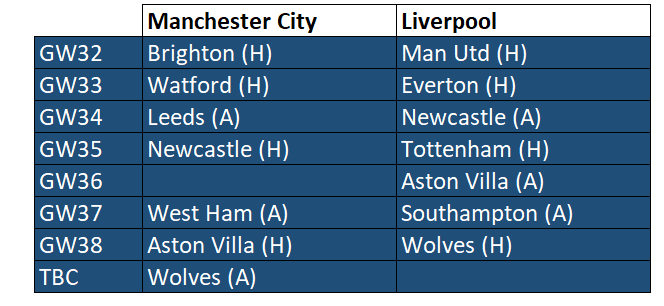
The two teams lock horns again in the FA Cup semi-finals next weekend and might meet again in a potential Champions League final if things go their way.
A lot of football is still to be played as both teams aim for historic campaigns.
City are dreaming of the treble.
Liverpool, the quadruple.





Comments